This week in class we had a screening of a 1998 German thriller film, “Run Lola, Run”. The film was written and directed by Tom Tykwer, and starring Franka Potente as Lola and Moritz Bleibtreu as Manni. The story follows a woman who needs to obtain 100,000 Deutsche Mark in twenty minutes to save her boyfriend’s (Manni’s) life.
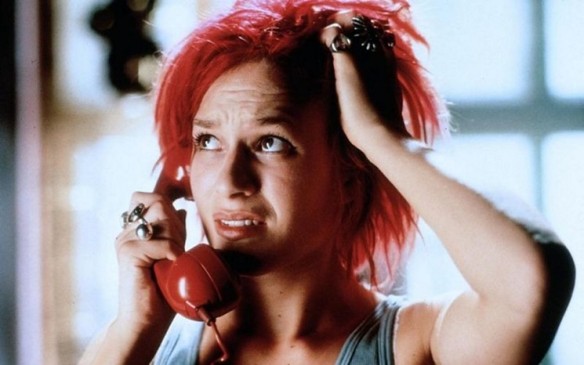
Through my own research and through an analytical article written about the film, I have gained an understanding of what I believe the director was trying to portray. From the article: “Tykwer belongs to a generation of Germans that embraces popular culture rather than criticizes it as a colonization of the mind and a form of cultural imperialism.” The director made this film with the pride of germany, adding in various parts of german culture as well as different themes throughout the movie that are seen in other german films and literature.
The film touches on themes such as the role of chance in people’s destiny, and obscure cause-effect relationships. Through brief flash-forward sequences of flashing images, Lola’s quick interactions with bystanders she encounters while she is running to Manni are revealed to have surprising and drastic effects on their future lives, serving as illustrations of a butterfly effect (However, another explanation is that Lola’s interactions with them didn’t really cause anything. It’s just that each person inherently has vastly different possibilities of ways that their lives could play out, and a different version of their lives is shown in the three different ways.) The film’s exploration of the relationship between chance and conscious intention is shown in the casino scene, where Lola appears to defy the laws of chance through sheer force of will, wishing with everything she had that she would win the money, and making the roulette ball land on her winning number with the help of her glass-shattering scream.
The thematic exploration of free will vs. determinism is made clear from the start. In the film’s brief prologue, a narrator asks a series of rhetorical questions that cause the audience to view the film through a metaphysical lens touching on philosophical questions. The theme is reinforced through the repeated appearance of a blind woman who briefly interacts with Manni in each alternative reality, and seems to have supernatural understandings of both the present and potential futures in those realities. By the final telephone booth scene in which the blind woman directs Manni’s attention to the man who stole his money in the beginning of the film, which allows him to finally retrieve his bag of money, saving his life.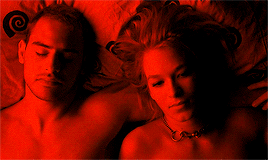
Several moments in the film show what seems to be a supernatural awareness of the characters. For example, in the first twenty minute reality sequence, Manni shows Lola how to use a gun by removing the safety, while in the second timeline she removes the safety as though she remembers what to do. This suggests that she might have the memory of the events depicted in the previous reality sequence. Also, the bank’s guard says to Lola “you finally came” in the third sequence, as if he possibly 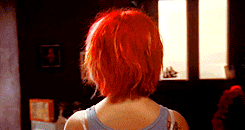 remembered Lola’s appearances in the previous two. There are other themes that are more obvious throughout the film; love, as seen through Lola and Manni’s relationship, and the kinds of things that love will lead people to do, also seen in the relationship with Lola’s Father and his mistress. Also, a big one, time. Time is the most obvious theme in the film, as there are many flashing images of clocks and watches, and the film being split up into four 20-minute sections.
remembered Lola’s appearances in the previous two. There are other themes that are more obvious throughout the film; love, as seen through Lola and Manni’s relationship, and the kinds of things that love will lead people to do, also seen in the relationship with Lola’s Father and his mistress. Also, a big one, time. Time is the most obvious theme in the film, as there are many flashing images of clocks and watches, and the film being split up into four 20-minute sections.
As for my reflection on this semester as a whole, I had a great semester with what content I learned from this class. Entering class, I was completely unaware of the kinds of things I would be learning about, and wasn’t all that interested, just took it because a friend told me I should. Throughout the course I found that the things we were talking about had an impact on my everyday life, being an artist and constantly creating work, I found myself influenced by and thinking more about the history of film while I was creating. I find that I am more interested in older films now, and I appreciate them much more than I previously did.
I found an almost immediate interest within the first half of the class, learning about old german horror films which I have always loved watching and learning about. Going through the different decades and learning but why filmmakers and production companies filmed what they did caused me to be more aware of things like that as I watch films now, as I never compared films that I like to other films of their time to realize those similarities that connected time frames and production companies to their films. One of my favorite weeks was the week that we learned about “midnight movies” and screened “the Rocky Horror Picture Show” which has been always been one of my all time favorites, but I never realized that in the 70’s there was such a cultural movement caused by films like this.
The Overall mood of class, seeing how interested and informed other students are in class, definitely made me intrigued to learn more about the films and the history of how and why they were made. I am registered for next semester to take “intro to film”, and heard about a “Cult Film” class that is happening next spring semester that I also am looking into taking! I hope that through taking these classes and learning about film that my art work will continue to hold those influences and I can sway my artwork in that way. Also as I start to form my schedules more around photography, I think that learning about film and incorporating that will be a big help in ideas composition of my work!



 usually seem to have a bit of sci-fi/ fantasy in them. Some examples of these films are “Back to the Future”, “Ghostbusters”, “Gremlins”(one of my favorites), “The Labyrinth”
usually seem to have a bit of sci-fi/ fantasy in them. Some examples of these films are “Back to the Future”, “Ghostbusters”, “Gremlins”(one of my favorites), “The Labyrinth” 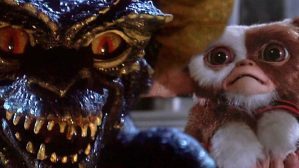 (even more of a favorite) and the movie that we were lucky enough to screen in class this week, “The Fly”. something that I love about films from the 80’s is the hopeless romance in them. This romance was heavily contrasted by horror and fear. These themes were not only played out on screen, but with the AIDS epidemic coming to play in the 80’s, this was also what was happening in real life.
(even more of a favorite) and the movie that we were lucky enough to screen in class this week, “The Fly”. something that I love about films from the 80’s is the hopeless romance in them. This romance was heavily contrasted by horror and fear. These themes were not only played out on screen, but with the AIDS epidemic coming to play in the 80’s, this was also what was happening in real life. 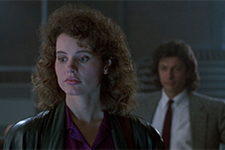 unrealistic fast moving romance of the 80’s, while also holding the extremely unrealistic and dramatic sci fi horror themes. I feel as though the pairing of the two themes is a tactic used to grab and hold the attention of several different audiences. I myself am more drawn to the romantic aspects of film, for the most part, which is why I enjoyed this film. But others who may hate romantic movies, but who love sci fi, would also find great enjoyment in this film. The love story between the two main characters, A scientist who has discovered but not perfected teleportation, and a journalist reporter trying to out his discovery until she quickly finds herself to have fallen in love with the scientist, was one that had me hooked quickly. This, also paired with the reporters own personal drama with her ex boyfriend/ boss was a great addition of drama to keep me interested throughout the entirety of the film. This film did an amazing job at holding a good amount of action from beginning to end, never trailing off or slowing down much. The special effects that became more and more apparent
unrealistic fast moving romance of the 80’s, while also holding the extremely unrealistic and dramatic sci fi horror themes. I feel as though the pairing of the two themes is a tactic used to grab and hold the attention of several different audiences. I myself am more drawn to the romantic aspects of film, for the most part, which is why I enjoyed this film. But others who may hate romantic movies, but who love sci fi, would also find great enjoyment in this film. The love story between the two main characters, A scientist who has discovered but not perfected teleportation, and a journalist reporter trying to out his discovery until she quickly finds herself to have fallen in love with the scientist, was one that had me hooked quickly. This, also paired with the reporters own personal drama with her ex boyfriend/ boss was a great addition of drama to keep me interested throughout the entirety of the film. This film did an amazing job at holding a good amount of action from beginning to end, never trailing off or slowing down much. The special effects that became more and more apparent 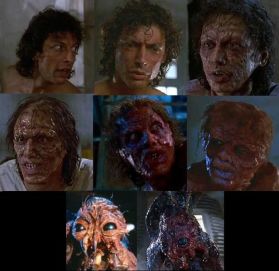 throughout the film as the scientist was morphed into a human sized fly after accidently teleporting himself with a fly in his teleportation machine, were just how special effects of the 80’s always looked. Very costume like, almost too much to take seriously, which gives a cheesy horror vibe which is a characteristic of old horror films that I love. Overall, I had a great time watching this film, the love story continued through to the very end where the audience gets to really feel the heartbreak of the ending of the relationship between the two main characters when the reporter is forced to shoot the scientist, as his body had completely changed into that of a fly’s, and he was deteriorating in front of her, grabbed the gun himself and held it to his own head, asking her to shoot him. A truly heartbreaking ending to this rollercoaster of a film.
throughout the film as the scientist was morphed into a human sized fly after accidently teleporting himself with a fly in his teleportation machine, were just how special effects of the 80’s always looked. Very costume like, almost too much to take seriously, which gives a cheesy horror vibe which is a characteristic of old horror films that I love. Overall, I had a great time watching this film, the love story continued through to the very end where the audience gets to really feel the heartbreak of the ending of the relationship between the two main characters when the reporter is forced to shoot the scientist, as his body had completely changed into that of a fly’s, and he was deteriorating in front of her, grabbed the gun himself and held it to his own head, asking her to shoot him. A truly heartbreaking ending to this rollercoaster of a film. 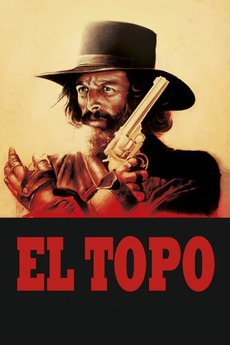 This week, we discussed cult films of the 1970’s. This topic has been the most interesting topic that we have learned about in class in my opinion. I have always been a huge fan of cult classics. These films marked an important era in film history, the era of the midnight movie. Midnight movie culture began in the early 1970’s with “El Topo” playing in New York City at the Elgin Theater, eventually spreading across America. This type of screening, playing non mainstream films late at night, was aimed at building this community of movie goers, a cult film audience, encouraging social interaction as well as repeat viewing of films. Going back to “El Topo”, this is a film I have never seen before. It is a 1970’s Mexican Western film that was written and directed the star of the film, Alejandro Jodorowsky. This film, marking the beginning of an era, could be considered the most influential of its time, as huge crowds of people swarmed to see this film, and countless amounts of articles and reviews were written about it. In my own opinion, it is not one that I wish to see myself. This is a highly controversial film, showing scenes of rape, and abuse, and the harsh violence is not something that I find entertainment in. Some other films that are categorized as 70’s cult films are “Pink Flamingos”, a film that I had the pleasure of watching this week, “A Clockwork Orange”, and our screening of the week, “The Rocky Horror Picture Show”
This week, we discussed cult films of the 1970’s. This topic has been the most interesting topic that we have learned about in class in my opinion. I have always been a huge fan of cult classics. These films marked an important era in film history, the era of the midnight movie. Midnight movie culture began in the early 1970’s with “El Topo” playing in New York City at the Elgin Theater, eventually spreading across America. This type of screening, playing non mainstream films late at night, was aimed at building this community of movie goers, a cult film audience, encouraging social interaction as well as repeat viewing of films. Going back to “El Topo”, this is a film I have never seen before. It is a 1970’s Mexican Western film that was written and directed the star of the film, Alejandro Jodorowsky. This film, marking the beginning of an era, could be considered the most influential of its time, as huge crowds of people swarmed to see this film, and countless amounts of articles and reviews were written about it. In my own opinion, it is not one that I wish to see myself. This is a highly controversial film, showing scenes of rape, and abuse, and the harsh violence is not something that I find entertainment in. Some other films that are categorized as 70’s cult films are “Pink Flamingos”, a film that I had the pleasure of watching this week, “A Clockwork Orange”, and our screening of the week, “The Rocky Horror Picture Show”

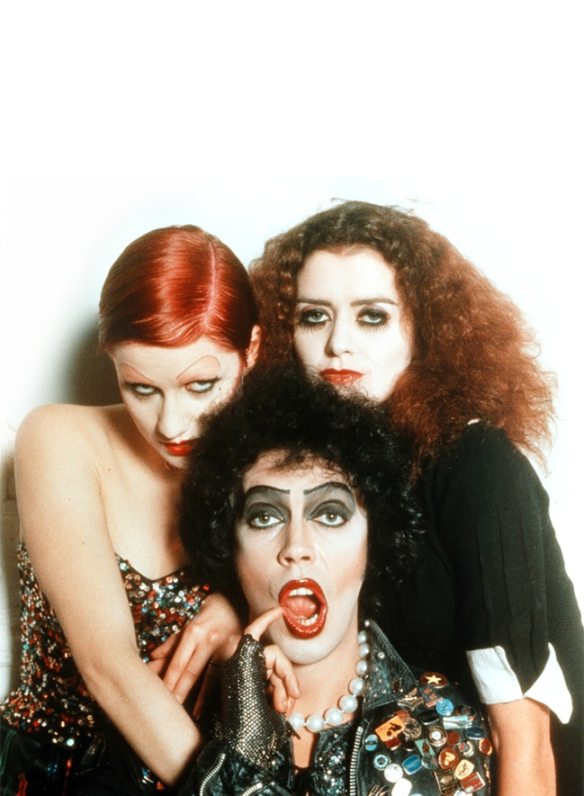
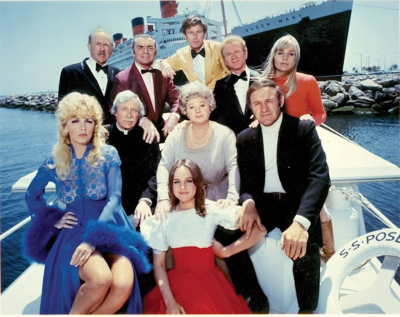 This week in class we did a screening of a film called “The Poseidon Adventure”. This is a 1972 film directed by Ronald Neame.produced by Irwin Allen, and based on Paul Gallico’s 1969 novel. It features a cast which includes five Academy Award winners: Gene Hackman; Ernest Borgnine; Jack Albertson; Shelley Winters; and Red Buttons. This film is categorized under “disaster films”, and it definitely fit that description. Going into to watching the film, I was not very excited, as this film was picked over many other amazing films such as Jaws, The Exorcist, Taxi Driver, ect. I had never heard of The Poseidon Adventure until wednesday’s class. The film starts off showing moments of different peoples lives as they travel on a cruise ship, which is taking its final voyage from New york City to Athens, and shows the boat heading towards and going through some pretty big waves. The people on the cruise ship go to big dinner, all dressed up. As the dinner is happening, a few key characters are focused in on. We watch their night unfold, and see their personal interactions with one another until ship suddenly is knocked over by a huge wave. The ship ends up upside in the ocean, causing the main characters to have to work together to navigate themselves through the ship, trying to find their way buy climbing and crawling through these dangerous obstacles, being lead by a preacher, Scott (Gene Hackman). Scott leads this small group of survivers throughout the ship, looking for the engine room that has a water tight door. Slowly, one by one while traveling through different parts of the ship which are flooded or on fire, we see many of the initial survivors die off. Once they reach the engine room, a broken pipe is spraying steam, blocking the doorway. Scott is seen jumping to the pipes valve, closing it off while giving a speech, asking God why has taken so many of them, and asking how many more God wants. After the steam is shut off, Scott drops to his death, and the few of the survivors who are left are rescued to safety.
This week in class we did a screening of a film called “The Poseidon Adventure”. This is a 1972 film directed by Ronald Neame.produced by Irwin Allen, and based on Paul Gallico’s 1969 novel. It features a cast which includes five Academy Award winners: Gene Hackman; Ernest Borgnine; Jack Albertson; Shelley Winters; and Red Buttons. This film is categorized under “disaster films”, and it definitely fit that description. Going into to watching the film, I was not very excited, as this film was picked over many other amazing films such as Jaws, The Exorcist, Taxi Driver, ect. I had never heard of The Poseidon Adventure until wednesday’s class. The film starts off showing moments of different peoples lives as they travel on a cruise ship, which is taking its final voyage from New york City to Athens, and shows the boat heading towards and going through some pretty big waves. The people on the cruise ship go to big dinner, all dressed up. As the dinner is happening, a few key characters are focused in on. We watch their night unfold, and see their personal interactions with one another until ship suddenly is knocked over by a huge wave. The ship ends up upside in the ocean, causing the main characters to have to work together to navigate themselves through the ship, trying to find their way buy climbing and crawling through these dangerous obstacles, being lead by a preacher, Scott (Gene Hackman). Scott leads this small group of survivers throughout the ship, looking for the engine room that has a water tight door. Slowly, one by one while traveling through different parts of the ship which are flooded or on fire, we see many of the initial survivors die off. Once they reach the engine room, a broken pipe is spraying steam, blocking the doorway. Scott is seen jumping to the pipes valve, closing it off while giving a speech, asking God why has taken so many of them, and asking how many more God wants. After the steam is shut off, Scott drops to his death, and the few of the survivors who are left are rescued to safety. 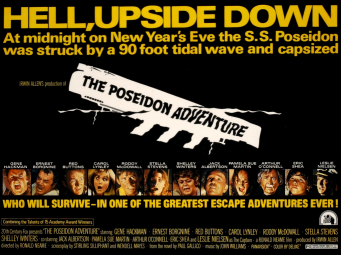 If i’m being honest, disaster films have never been favorites of mine. I have always felt that the plots and reality of disaster films are
If i’m being honest, disaster films have never been favorites of mine. I have always felt that the plots and reality of disaster films are 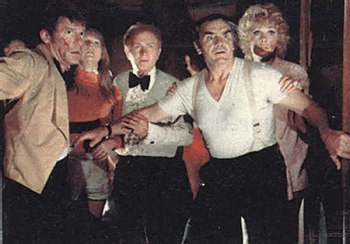 just unrealistic and slightly uninteresting. In this film however, I was drawn to some of the characters, appreciating their backstory and character build up, which helped with then showing how these people with different back stories interact with one another.
just unrealistic and slightly uninteresting. In this film however, I was drawn to some of the characters, appreciating their backstory and character build up, which helped with then showing how these people with different back stories interact with one another. 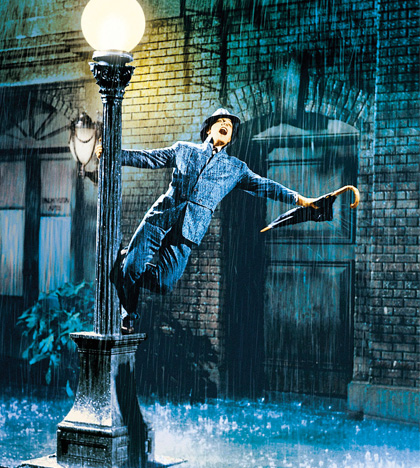 The main character in the film, Don Lockwood, is an actor, who also has a background in singing, dancing, and is a stunt man. Hs is matched with a young Hollywood actress for publicity for their movies, but this actress believes, despite being told multiple times otherwise, that her relationship with Don is real off screen as well. Don meets a showgirl, played by Debbie Reynolds, who becomes his new love interest, making his co-actress upset and jealous. The film goes on to show the shift in hollywood production as well as moving through the relationships of people who were involved in making that shift.
The main character in the film, Don Lockwood, is an actor, who also has a background in singing, dancing, and is a stunt man. Hs is matched with a young Hollywood actress for publicity for their movies, but this actress believes, despite being told multiple times otherwise, that her relationship with Don is real off screen as well. Don meets a showgirl, played by Debbie Reynolds, who becomes his new love interest, making his co-actress upset and jealous. The film goes on to show the shift in hollywood production as well as moving through the relationships of people who were involved in making that shift.  car of a woman, who happens to be Bonnie’s mother. Bonnie at the time is bored with her life and her job as a waitress; she is intrigued by Clyde and decides to be his partner in crime. Throughout the movie, Bonnie and Clyde are shown throughout their entire relationship, portraying their kind personalities outside of the crimes they commit, and telling a story of two people falling in love. Together they kill police officers and bank tellers, while being very kind to others, showing sympathy and compassion; to me, Bonnie and Clyde were only out to fight real
car of a woman, who happens to be Bonnie’s mother. Bonnie at the time is bored with her life and her job as a waitress; she is intrigued by Clyde and decides to be his partner in crime. Throughout the movie, Bonnie and Clyde are shown throughout their entire relationship, portraying their kind personalities outside of the crimes they commit, and telling a story of two people falling in love. Together they kill police officers and bank tellers, while being very kind to others, showing sympathy and compassion; to me, Bonnie and Clyde were only out to fight real 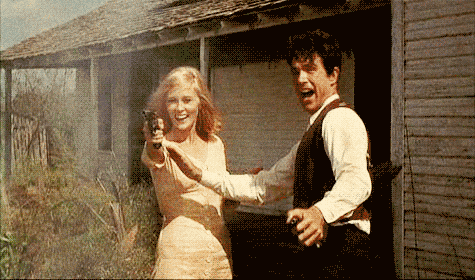 problems in the world, the messed up police system, and capitalism. At the end of the film, the couple is at their happiest, having just decided that they were going to get married, when police massacre them, but not before they give each other a look of pure love and of knowing they have no regrets. The film was very good, and with knowing that this is a true story, it was much more upsetting to see the ending of the film.
problems in the world, the messed up police system, and capitalism. At the end of the film, the couple is at their happiest, having just decided that they were going to get married, when police massacre them, but not before they give each other a look of pure love and of knowing they have no regrets. The film was very good, and with knowing that this is a true story, it was much more upsetting to see the ending of the film. 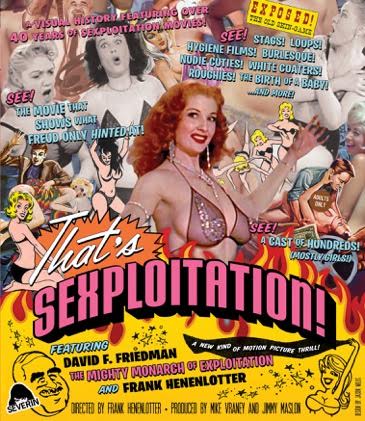
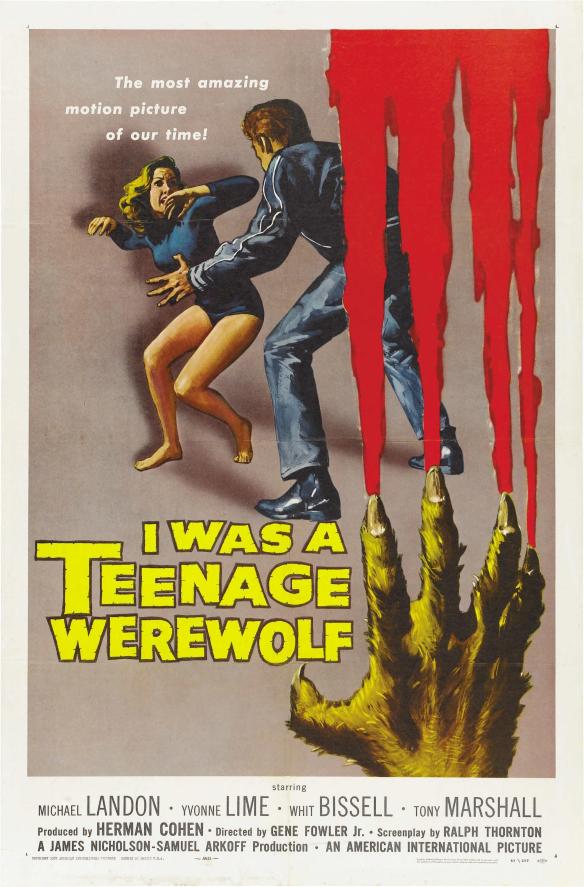
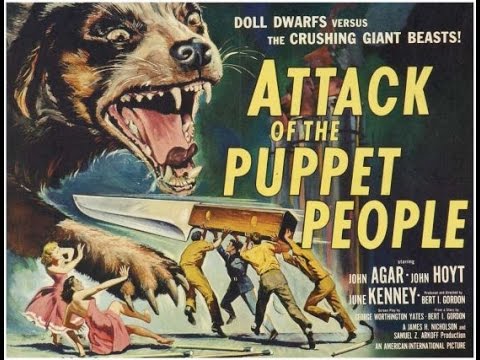
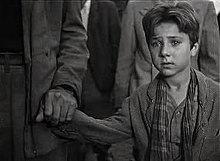


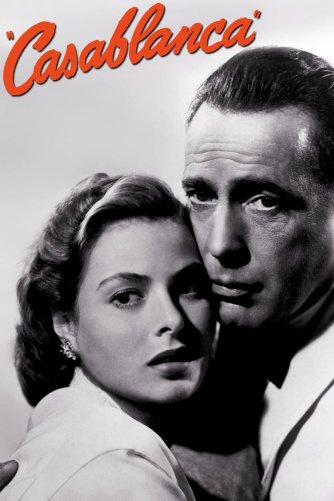
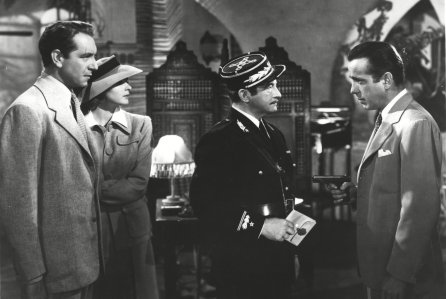
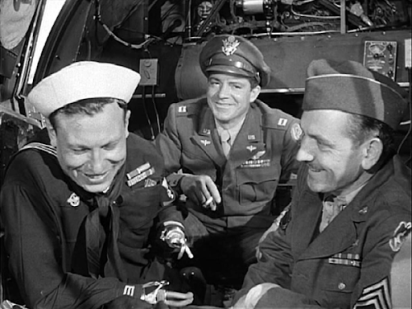 On wednesday, group one gave its presentation on the movie “The Best Years of our lives”. I have never seen this film, but the group did a very nice job at explaining each of their parts to help us understand the movie. The group members seemed very informed and excited to talk about the film and gave great insights. They also were able to conduct a lot of conversation during their presentation. I liked that the group played the trailer of the film, which showed how differently movies are advertised today than they used to be. The film being about men returning home from the war, seemed to be made into a love story for the trailer, excluding important characters and including unimportant characters. It seems that the way people viewed films in the past was different, like the majority wanted to see these love stories, and not anything having to do with the war or violence, so the trailers were altered in order to make them appeal more to the general public.
On wednesday, group one gave its presentation on the movie “The Best Years of our lives”. I have never seen this film, but the group did a very nice job at explaining each of their parts to help us understand the movie. The group members seemed very informed and excited to talk about the film and gave great insights. They also were able to conduct a lot of conversation during their presentation. I liked that the group played the trailer of the film, which showed how differently movies are advertised today than they used to be. The film being about men returning home from the war, seemed to be made into a love story for the trailer, excluding important characters and including unimportant characters. It seems that the way people viewed films in the past was different, like the majority wanted to see these love stories, and not anything having to do with the war or violence, so the trailers were altered in order to make them appeal more to the general public. 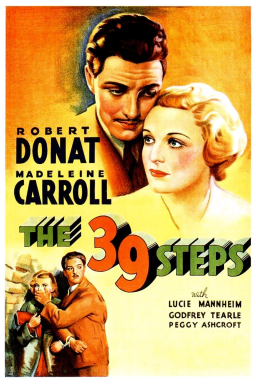 After group one presented, we continued to watch the film, “The 39 Steps”, directed by Alfred Hitchcock. I have seen this movie before, but have always found it difficult to fully keep up with the story line and know exactly what was going on. In my opinion, the film seems messy and hard to follow, with the main story line being all over the place with things happening very quickly and then not being talked about again. This movie is low on my list of Alfred Hitchcock films, nowhere near comparing to films like, “psycho” or “The Birds”. Something that is done well in the film however, is the way Hitchcock is able to the let the audience know that something violent has happened without actually showing them the violent action. If any sort of violent contact is made, the camera is not showing it, but the way that Hitchcock directs, makes the reactions of the actors and the music in the background send a clear message of the violence that has happened. This is something to respect about Hitchcock, the way he walked around the guidelines that were being placed on his films.
After group one presented, we continued to watch the film, “The 39 Steps”, directed by Alfred Hitchcock. I have seen this movie before, but have always found it difficult to fully keep up with the story line and know exactly what was going on. In my opinion, the film seems messy and hard to follow, with the main story line being all over the place with things happening very quickly and then not being talked about again. This movie is low on my list of Alfred Hitchcock films, nowhere near comparing to films like, “psycho” or “The Birds”. Something that is done well in the film however, is the way Hitchcock is able to the let the audience know that something violent has happened without actually showing them the violent action. If any sort of violent contact is made, the camera is not showing it, but the way that Hitchcock directs, makes the reactions of the actors and the music in the background send a clear message of the violence that has happened. This is something to respect about Hitchcock, the way he walked around the guidelines that were being placed on his films.